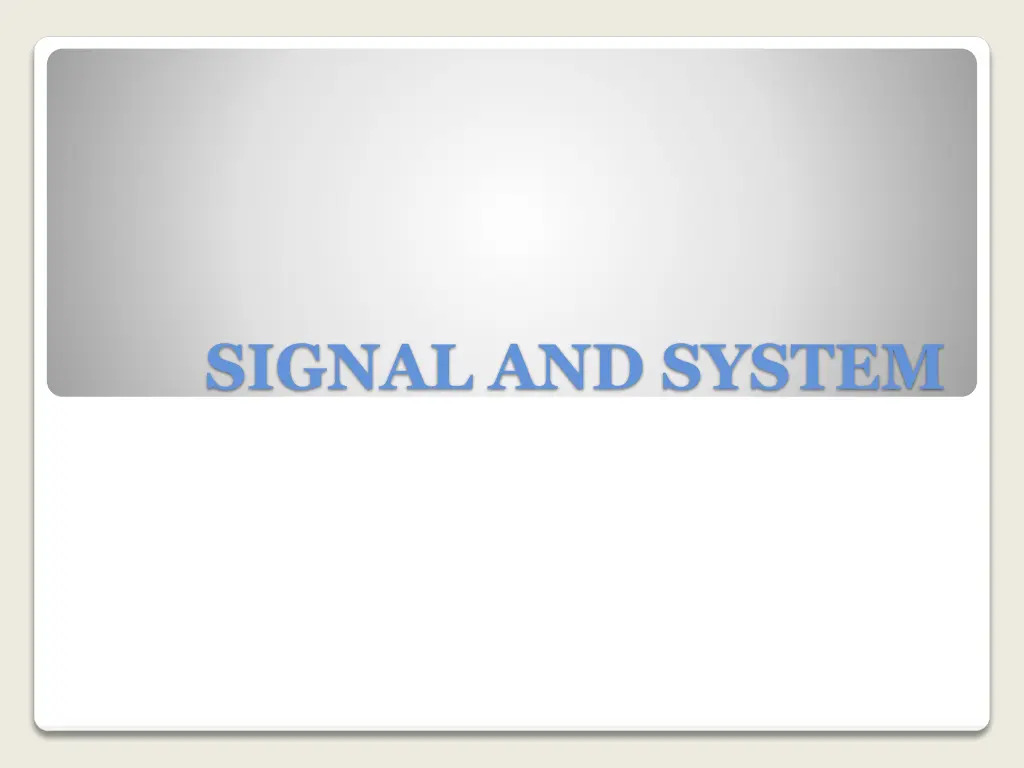
Understanding Signal and System Fundamentals
Explore the basics of signals and systems, including the definition of signals, types of signals, systems, signal classifications, periodicity, deterministic and random signals. Gain insights into CT and DT signals and the concepts of even and odd signals. Enhance your knowledge in this foundational area of electrical engineering.
Download Presentation

Please find below an Image/Link to download the presentation.
The content on the website is provided AS IS for your information and personal use only. It may not be sold, licensed, or shared on other websites without obtaining consent from the author. If you encounter any issues during the download, it is possible that the publisher has removed the file from their server.
You are allowed to download the files provided on this website for personal or commercial use, subject to the condition that they are used lawfully. All files are the property of their respective owners.
The content on the website is provided AS IS for your information and personal use only. It may not be sold, licensed, or shared on other websites without obtaining consent from the author.
E N D
Presentation Transcript
What are they? Signal System General Introduction
Signal: a function of one or more variables that convey information on the nature of a physical phenomenon. Examples: v(t),i(t),x(t),heartbeat, blood pressure, temperature, vibration. One-dimensional signals: function depends on a single variable, e.g., speech signal Multi-dimensional signals: function depends on two or more variables, e.g., image Fundamentals of Signals and Systems
System: an entity or operator that manipulates one or more signals to accomplish a function, thereby yielding new signals. Output signal Input signal System Commonly encountered systems: communications systems Automatic speaker recoginition system Aircraft landing system . Fundamentals of Signals and Systems
1. CT and DT signals: Classification of signals
For many cases, x[n] is obtained by sampling x(t) as: x[n] = x(nT) , n =0,+1,+2, Are there any requirements for the sampling? Classification of signals (cont.)
2. Even and odd signals: Even: x( t) = x(t) x[ n] = x[n] Odd: x( t) = x(t) x[ n] = x[n] Any signal x(t) can be expressed as x(t) = xe(t) + xo(t) ) x( t) = xe(t) xo(t) where xe(t) = 1/2(x(t) + x( t)) xo(t) = 1/2(x(t) x( t)) Classification of signals (cont.)
3. Periodic and non-periodic signals: CT signal: if x(t) = x(t + T), then x(t) is periodic. Smallest T=Fundamental period: To Fundamental frequency fo = 1/To (Hz or cycles/second) Angular frequency: o = 2 /To (rad/seconds) DT signal: if x[n] = x[n + N], then x[n] is periodic. min(No): fundamental period Fo = 1/No (cycles/sample) =2 /N (rads/sample). If the unit of n is designated as dimensionless, then is simply in radians. Note: A sampled CT periodic signal may not be DT periodic. Any Condition addition of two periodic CT signals, resultant must be periodic signal ? Classification of signals (cont.)
4. Deterministic and random signals. Deterministic signal: No uncertainty with respect to its value at any time Completely specified at any time Random signal: Uncertain before it occurs. E.g., thermal noise. Classification of signals (cont.)
Energy and power signals: CT signal x(t): lim T 2( ) x t dt Energy: E = T 1 T 2 ( ) x t dt Power: P = 2 T Classification of signals (cont.)
DT signal x[n]: n 2 x Energy: E = 1 N + Power: lim N 2 x n 2 1 N = n N Energy signal: if 0 < E < Power signal: if 0 < P < Classification of signals (cont.)
Analog Signal and Digital Signal Classification of signals (cont.)
Basic operations on signals Basic Operations on Signal
Rule for time shifting and time scaling: See figure below. Find y(t) = x(2t + 3). Basic Operations on Signal(cont.)
1. Exponential 2-Sinusoidal Elementary signals
3. Step function Elementary signals(cont.)
4.Unit impulse function 5.Unit ramp function Elementary signals(cont.)
2.Memory /Memoryless Memory system: present output value depend on future/past input. Memoryless system: depend only on present input. Example present output value System Properties(cont.)
Invertibility y(t) x(t) x(t) 1 H H System Properties(cont.)
Series(cascade) Interconnection System 1 System 2 Input Output Parallel, Interconnection System 1 Output Input + System 2 Interconnection of systems
Feedback Interconnection Input Output System 1 System 2 Interconnection of systems
